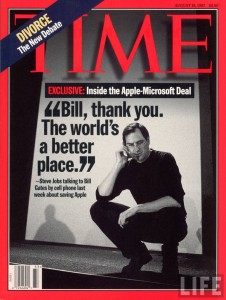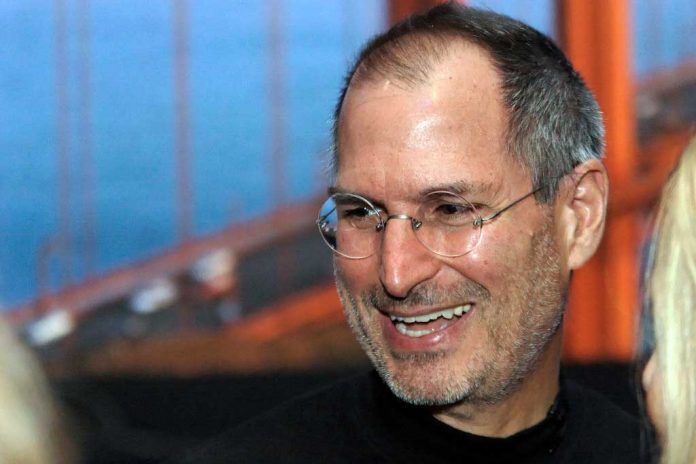Help from the archenemy

The change induced by Steve Jobs had radical impacts. He brutally cleaned up the Apple management, dramatically reduced the product range, killed John Sculley’s ambitious Newton project, cancelled the agreements with producers of Macintosh clones, and brought non other than his adversary Bill Gates as savior on board. At the 1997 MacWorld Expo in Boston, the Microsoft CEO proclaimed on a giant video screen that the world’s largest software maker would buy Apple shares worth 150 million dollars, and would continue to develop the Office suite for the Mac.
The Apple fan community was shocked and there were loud choruses of boos against Jobs and Gates, but Jobs remained on his course: “If we want to move forward and see Apple healthy again, we have to let go of a few things here,” Jobs told the audience. “We have to let go of this notion that for Apple to win, Microsoft has to lose.” . . . I think if we want Microsoft Office on the Mac, we better treat the company that puts it out with a little bit of gratitude.”
After he regained power at Apple Jobs then fired those whom he considered as losers and rip-off artists who had brought the company to the edge of bankruptcy. However, not everyone suffered from the rage of the iCEO: “Apple was about 90 days away from going bankrupt – back then in the early days,” the Apple CEO said 13 years later in retrospect at the conference D8 AllThingsD.
It was much worse than I thought when I went back initially. But there were people there who — I expected all the good people would’ve left. I found these miraculous people, this great people. And I said: ‘What? – I tried to ask this as tactful as possible – Why are you still here? And you know, a lot of them had this phrase: They said, because I bleed in colors – which was the old six color apple logo.
The young designer Jony Ive was one of these frustrated and undiscovered geniuses of Apple at that time. “He was sick of the company’s focus on profit maximization rather than product design,” writes Walter Isaacson in Steve Jobs’ official biography. The Briton, who was then 30-years old, said: “I remember very clearly Steve announcing that our goal is not just to make money but to make great products.” Ive worked at Apple since 1992, but had been fully ignored by the Apple bosses Sculley, Spindler, and Amelio.
Read the next page: The old/new Apple design: Less is more




[…] The Legend of Steve Jobs – His Life and Career » Mac History. Steve Wozniak and Steve Jobs […]
[…] time Apple has used an iconic design for an iOS app. The original iOS calculator used a design that paid homage to the classic Braun ET44 calculator. Apple SVP of Industrial Design Jonathan Ive is well-known as […]
[…] time Apple has used an iconic design for an iOS app. The original iOS calculator used a design that paid homage to the classic Braun ET44 calculator. Apple SVP of Industrial Design Jonathan Ive is well-known as […]
[…] time Apple has used an iconic design for an iOS app. The original iOS calculator used a design that paid homage to the classic Braun ET44 calculator. Apple SVP of Industrial Design Jonathan Ive is well-known as […]
[…] of German designer Dieter Rams defender simplicity and functionalism to inspire Steve Jobs and his Apple universe, in addition to Banzi, which would connect his brain chips from the first approach to […]
[…] Dieter Rams, defensor p la simplicidad junto con el funcionalismo que inspiraría a Jobs y a su universo Apple, además p a Banzi, que conectaría los chips p su cerebro a partir p ose primer acercamiento a la […]
[…] was the graphical user interface. I thought it was the best thing I’d ever seen in my life” (Steve Jobs 1995) Inspired by this amazing experience in 1983 Steve Jobs brought out “The Apple […]
[…] influenced the designers at Apple. See here and here. I’m not about to have a rant about the brazen similarities, its more to […]
[…] read about Steve Jobs and Dieter Rams. It talks about how Steve Jobs was highly influenced by the many years of work and design success […]
[…] Dernbach, Christoph. “The Legend of Steve Jobs – His Life and Career.” Mac History, Mac History, 1 Feb. 2015, http://www.mac-history.net/steve-jobs/2012-10-30/the-legend-of-steve-jobs-his-life-and-career […]
[…] Dieter Rams, defensor de la simplicidad y el funcionalismo que inspiraría a Steve Jobs y a su universo Apple, además de a Banzi, que conectaría los chips de su cerebro a partir de ese primer acercamiento a […]